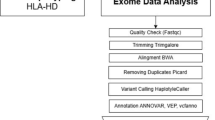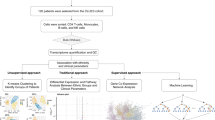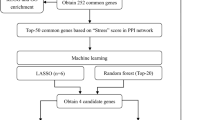Abstract
Multiple sclerosis (MS) is a complex autoimmune disease affecting genetically susceptible individuals. A genome-wide association study performed by the International MS Genetics Consortium identified several putative susceptibility genes; among these, the KLRB1 gene is represented by the single-nucleotide polymorphism rs4763655. We could confirm a marginally significant association between rs4763655 and MS (P=0.046, odds ratio=1.06 (1.00–1.13)) in a large Scandinavian case–control study of 5367 MS patients and 4485 controls. The expression of KLRB1 in blood from MS patients was higher compared with healthy controls (P<0.001), and the KLRB1 expression decreased significantly (P<0.001) after interferon (IFN)-β treatment. KLRB1 was expressed in T and natural killer (NK) cells, and expression mainly decreased in NK cells in patients treated with IFN-β. Collectively, our results indicate that KLRB1 gene expression is altered in MS and likely to be involved in the pathogenesis of the disease, whereas rs4763655 in KLRB1 seems to have a minimal role in MS susceptibility.
Similar content being viewed by others
Log in or create a free account to read this content
Gain free access to this article, as well as selected content from this journal and more on nature.com
or
References
Hedstrom AK, Baarnhielm M, Olsson T, Alfredsson L : Tobacco smoking, but not Swedish snuff use, increases the risk of multiple sclerosis. Neurology 2009; 73: 696–701.
Ebers GC : Environmental factors and multiple sclerosis. Lancet Neurol 2008; 7: 268–277.
Oksenberg JR, Baranzini SE : Multiple sclerosis genetics-is the glass half full, or half empty? Nat Rev Neurol 2010; 6: 429–437.
Jersild C, Fog T, Svejgaard A : Hl-A antigens and multiple-sclerosis. Lancet 1972; 1: 1240.
Bush WS, Sawcer SJ, De Jager PL et al: Evidence for polygenic susceptibility to multiple sclerosis--the shape of things to come. Am J Hum Genet 2010; 86: 621–625.
Hafler DA, Compston A, Sawcer S et al: Risk alleles for multiple sclerosis identified by a genomewide study. N Engl J Med 2007; 357: 851–862.
Lanier LL, Chang C, Phillips JH : Human NKR-P1A. A disulfide-linked homodimer of the C-type lectin superfamily expressed by a subset of NK and T lymphocytes. J Immunol 1994; 153: 2417–2428.
Cosmi L, De Palma R, Santarlasci V et al: Human interleukin 17-producing cells originate from a CD161(+)CD4(+) T cell precursor. J Exp Med 2008; 205: 1903–1916.
Vivier E, Tomasello E, Baratin M, Walzer T, Ugolini S : Functions of natural killer cells. Nat Immunol 2008; 9: 503–510.
Rosen DB, Cao W, Avery DT et al: Functional consequences of interactions between human NKR-P1A and its ligand LLT1 expressed on activated dendritic cells and B cells. J Immunol 2008; 180: 6508–6517.
Aldemir H, Prod’homme V, Dumaurier MJ et al: Cutting edge: lectin-like transcript 1 is a ligand for the CD161 receptor. J Immunol 2005; 175: 7791–7795.
Rosen DB, Bettadapura J, Alsharifi M, Mathew PA, Warren HS, Lanier LL : Cutting edge: lectin-like transcript-1 is a ligand for the inhibitory human NKR-P1A receptor. J Immunol 2005; 175: 7796–7799.
Polman CH, Reingold SC, Edan G et al: Diagnostic criteria for multiple sclerosis: 2005 revisions to the ‘McDonald Criteria’. Ann Neurol 2005; 58: 840–846.
Krakauer M, Sorensen P, Khademi M, Olsson T, Sellebjerg F : Increased IL-10 mRNA and IL-23 mRNA expression in multiple sclerosis: interferon-beta treatment increases IL-10 mRNA expression while reducing IL-23 mRNA expression. Mult Scler 2008; 14: 622–630.
Livak KJ, Schmittgen TD : Analysis of relative gene expression data using real-time quantitative PCR and the 2(T)(-Delta Delta C) method. Methods 2001; 25: 402–408.
Novembre J, Johnson T, Bryc K et al: Genes mirror geography within Europe. Nature 2008; 456: 98–101.
Purcell S, Neale B, Todd-Brown K et al: PLINK: A tool set for whole-genome association and population-based linkage analyses. Am J Hum Genet 2007; 81: 559–575.
Hesse D, Krakauer M, Lund H et al: Breakthrough disease during interferon-[beta] therapy in MS: no signs of impaired biologic response. Neurology 2010; 74: 1455–1462.
De Jager PL, Rossin E, Pyne S et al: Cytometric profiling in multiple sclerosis uncovers patient population structure and a reduction of CD8(low) cells. Brain 2008; 131: 1701–1711.
Sellebjerg F, Ross C, Koch-Henriksen N et al: CD26+ CD4+ T cell counts and attack risk in interferon-treated multiple sclerosis. Mult Scler 2005; 11: 641–645.
Takahashi K, Aranami T, Endoh M, Miyake S, Yamamura T : The regulatory role of natural killer cells in multiple sclerosis. Brain 2004; 127: 1917–1927.
Bielekova B, Catalfamo M, Reichert-Scrivner S et al: Regulatory CD56(bright) natural killer cells mediate immunomodulatory effects of IL-2Ralpha-targeted therapy (daclizumab) in multiple sclerosis. Proc Natl Acad Sci USA 2006; 103: 5941–5946.
Johansson S, Berg L, Hall H, Hoglund P : NK cells: elusive players in autoimmunity. Trends Immunol 2005; 26: 613–618.
Acknowledgements
We thank Joy Mendel-Hartvig, Vibeke Fuglholt and Marie Koefoed for excellent laboratory work. The Danish MS Society, the Warwara Larsen Foundation, the Johnsen Foundation and The Danish Council for Strategic Research supported the Danish part of the study. The Research Council of Norway and South Eastern Norway Regional Health Authority supported the Norwegian part of the study. We thank the Norwegian Bone Marrow Donor Registry for collaboration in establishment of the Norwegian control material, and we acknowledge the Norwegian MS Register and Biobank for contribution of a proportion of the MS samples. Swedish Medical Research Council financed the Swedish part of the project (sample collection). Grants were provided by the Swedish Council for Working Life and Social Research, the fp6 EU program Neuropromise (LSHM-CT-2005-018637), Bibbi and Niels Jensens Foundation, Montel Williams Foundation, the Söderberg foundation and the Swedish Association for Persons with Neurological Disabilities.
Author information
Authors and Affiliations
Corresponding author
Ethics declarations
Competing interests
HBS, ML, JRC, EGC, IK, ILM, HFH and LB declare no conflict of interest. JH has received unrestricted research support from Biogen Idec, MercSerono and Bayer-Schering. TO has received unrestricted research support from Biogen Idec, Merck Serono, Sanofi-Aventis and Bayer Shering. KMM has received honoraria for lecturing and travel expenses for attending meetings, and research support from Biogen Idec, Bayer, Merck Serono or Sanofi-Aventis. FS has received honoraria for consulting or lecturing, travel grants or research grants from Bayer-Schering, Biogen Idec, Merck Serono, Novo Nordisk, Sanofi-Aventis, Schering-Plough and Teva; PSS has received funding, honoraria for consulting or lecturing or research grants from Baxter, Bayer-Schering, Biogen Idec, BioMS Medical, Merck Serono, Novartis, Sanofi-Aventis and Teva. ABO received travel grants and speakers honoraria from Biogen Idec, Bayer-Schering Pharma and Merck Serono.
Additional information
Supplementary Information accompanies the paper on European Journal of Human Genetics website
Rights and permissions
About this article
Cite this article
Søndergaard, H., Sellebjerg, F., Hillert, J. et al. Alterations in KLRB1 gene expression and a Scandinavian multiple sclerosis association study of the KLRB1 SNP rs4763655. Eur J Hum Genet 19, 1100–1103 (2011). https://doi.org/10.1038/ejhg.2011.88
Received:
Revised:
Accepted:
Published:
Issue date:
DOI: https://doi.org/10.1038/ejhg.2011.88



